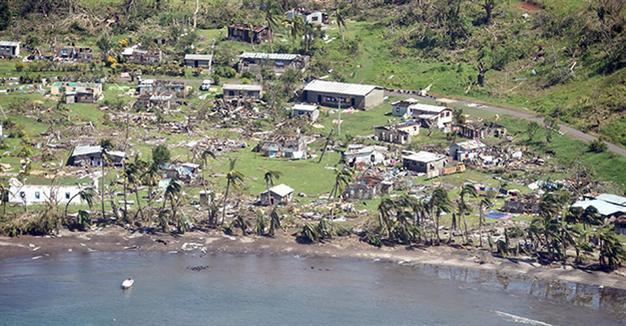Cyclone death toll hits 29 as Fiji eyes long clean-up
SUVA, Fiji - Agence France-Presse

A handout photo taken on 22 February, 2016 and obtained on 23 February, shows damage to Taviya village after the most powerful cyclone in Fiji's history battered the Pacific island nation. AFP Photo
Humanitarian aid began pouring into Fiji on Feb. 23, as the death toll from super-cyclone Winston rose to 29 and officials warned the devastated Pacific nation's recovery could take months.
With authorities still struggling to grasp the scale of the disaster on remote island communities, Australian and New Zealand planes arrived laden with desperately needed supplies of food, water and medicine.
Government spokesman Ewan Perrin said the news was grim from villages which had managed to restore communications after the storm hit overnight on Feb. 20.
"The official death toll now is 29, another eight bodies were found on the island of Koro since yesterday," Perrin told Radio New Zealand in a phone interview.
"We are expecting it to rise but we're hoping it's going to rise by a very small number."
Severe tropical cyclone Winston, the most powerful storm ever recorded in the southern hemisphere, lashed Fiji with wind gusts of 325 kilometers (202 miles) per hour, leaving a trail of destruction.
More than 8,000 people are still sheltering in evacuation centers and Perrin said some villages had hardly any buildings left standing.
"We're still trying to get people on the ground in these areas to do a detailed assessment of the damage. We're just taking it day-by day," he said.
"In some places people are going to be displaced for months because they've lost everything."
The rising toll makes Winston the deadliest cyclone to ever hit Fiji, according to figures cited by the Fiji Broadcasting Corporation.
Perrin said 2,000 families were homeless on Koro alone and two ships were steaming to the island with relief supplies.
"We haven't been able to make contact with all parts of Fiji, although with the assistance of the New Zealand Air Force we've managed to do aerial inspections across almost all of the islands," he added.
"There's considerable damage of course across the top of the main island (Viti Levu) and the island of Koro, which took pretty much a direct hit."
New Zealand military photographs show entire villages flattened by the first category five storm to hit Fiji, washing out bridges and flooding schools.
Many homes were reduced to piles of kindling, with roofing and furniture strewn about.
In one image a lone man stands on the tin roof of his ruined home, apparently waving both arms at the military plane as it passes overhead.
In another, a large steel-hulled ship sits high on a beach after being driven ashore in huge swells.
"The images emerging from early aerial assessments of affected areas are truly heartbreaking, leaving little doubt about the ferocity of this cyclone," said the UN's Fiji coordinator Osnat Lubrani.
"It is clear from these catastrophic impacts that Fiji is facing a long road to recovery."
The nation has declared a month-long state of natural disaster after a storm that Prime Minister Voreqe Bainimarama described as an "assault on Fiji".
Power is gradually being restored in the main centers and roads cleared of felled trees.
The international airport at Nadi also reopened on Feb. 22, allowing international tourists caught up in the disaster to return home.
Aid efforts have ramped up, with Australia contributing a Aus $5.0 million (US$3.6 million) package and New Zealand NZ$2.2 million (US$1.5 million).
Wellington has mobilized two military aircraft, while Canberra is sending two planes and four helicopters, as well as specialized medivac teams.
UN aid chief Stephen O'Brien said hundreds of thousands of Fijians had been affected.
"We must do all we can to help people rebuild their lives and livelihoods," he said in a statement from New York.
The European Union said it had sent a disaster management expert to assess the best way it could respond.
Aid agencies such as the Red Cross, Oxfam, Care Australia and Save the Children are on the ground distributing supplies and providing expertise on issues such as sanitation in evacuation centers.
